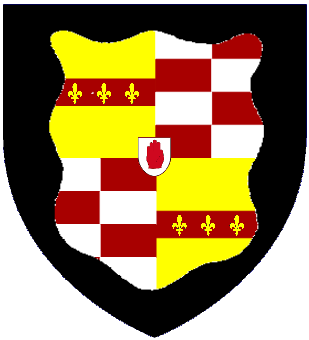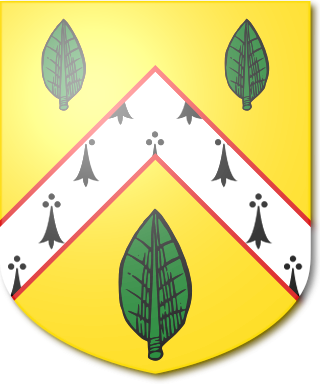
Viscount Hardinge, of Lahore and of Kings Newton in the County of Derby, is a title in the Peerage of the United Kingdom. It was created in 1846 for the soldier and Tory politician Sir Henry Hardinge. His son, the second Viscount, represented Downpatrick in Parliament. His great-great-grandson, the sixth Viscount, succeeded a distant relative as eighth Baronet, of Belle Isle in the County of Fermanagh, in 1986. This title had been created in the Baronetage of the United Kingdom 1801 for Richard Hardinge. He was the third son of Nicolas Hardinge, younger brother of Reverend Henry Hardinge and uncle of the latter's third son Henry Hardinge, 1st Viscount Hardinge. The baronetcy was created with special remainder to the heirs male of Richard Hardinge's father.

The Bartlett Baronetcy, of Hardington-Mandeville in the County of Somerset, is a title in the Baronetage of the United Kingdom. It was created on 7 February 1913 for the civil engineer and contractor Herbert Bartlett. The baronetcy considered is considered dormant.

The Strachey baronetcy, of Sutton Court in the County of Somerset, England, is a title in the Baronetage of the United Kingdom. This family was originally seated at Walden, Essex, where William Strachey was living under the rule of Edward VI. Later they moved to Surrey and at last settled at Sutton Court, Somerset. The title was created on 15 June 1801 for the politician and civil servant Henry Strachey. Sir Henry was private secretary to Lord Clive during his last expedition to India in 1764. He also took part in negotiations for peace with North America where he assisted the kings commissioners at Paris. He died in 1809 and was succeeded by his eldest son Henry, the second Baronet Strachey. His great-grandson, the fourth Baronet, was a Liberal politician. On 3 November 1911, he was created Baron Strachie, of Sutton Court in the County of Somerset, in the Peerage of the United Kingdom. He later served as Paymaster General. The peerage became extinct on the death of his son, the second Baron, in 1973. The baronetage is currently dormant.

The Barrett-Lennard Baronetcy, of Belhus in the County of Essex, is a title in the Baronetage of the United Kingdom. It was created on 30 June 1801 for Thomas Barrett-Lennard, subsequently Member of Parliament for Essex South. He was the illegitimate son and testamentary heir of Thomas Barrett-Lennard, 17th Baron Dacre. He was succeeded by his grandson, the second Baronet, the son of Thomas Barrett-Lennard, Member of Parliament for Maldon. His son, the third Baronet, was childless and was succeeded by his younger brother, the fourth Baronet. This line of the family failed on the death in 1977 of his son, the fifth Baronet, who died without male issue. The late Baronet was succeeded by his third cousin once removed, the sixth Baronet. He was the son of Sir Fiennes Cecil Arthur Barrett-Lennard, Chief Justice of Jamaica, son of Captain Thomas George Barrett-Lennard, son of the first marriage of George Barrett-Lennard, son of John Barrett-Lennard, second son of the first Baronet. The sixth Baronet was a Catholic clergyman. As of 2014 the title is held by his second cousin, the seventh Baronet, who succeeded in 2007. He is the grandson of Trenchard Barrett-Lennard, son of the aforementioned George Lennard-Barrett by his second marriage. As of 31 December 2013 the present Baronet has not successfully proven his succession and is therefore not on the Official Roll of the Baronetage, with the baronetcy considered vacant since 2007.

The Baynes Baronetcy, of Harefield Place in the County of Middlesex, is a title in the Baronetage of the United Kingdom. It was created on 29 June 1801 for Christopher Baynes. He was Major-Commandant of the Uxbridge Gentlemen and Yeomanry Cavalry, which he helped to raise. The title descended from father to son until the death of his great-great-grandson, the fifth Baronet, in 1971. The late Baronet died unmarried and was succeeded by his first cousin, the sixth Baronet. He was the son of Reverend Malcolm Charles Baynes, fourth son of the third Baronet. As of 2023 the title is held by his grandson, the eighth Baronet, who succeeded his father in 2005.

The Wrixon-Becher Baronetcy, of Ballygiblin in the County of Cork, is a title in the Baronetage of the United Kingdom. It was created on 30 September 1831 for William Wrixon-Becher, Member of Parliament for Mallow from 1818 to 1826. Born George Wrixon, he assumed by Royal licence his mother's maiden surname of Becher in 1831. The Becher family were major landowners in County Cork.

The Walsham Baronetcy, of Knill Court in the County of Hereford, was a title in the Baronetage of the United Kingdom. It was created on 30 September 1831 for John James Walsham. He received the baronetcy as the eldest co-heir and representative of Sir Thomas Morgan, 1st Baronet. The second Baronet was Envoy Extraordinary and Minister Plenipotentiary to China from 1885 to 1892 and to Romania from 1892 to 1893. The fourth Baronet was a rear admiral in the Royal Navy.

The Couper Baronetcy is a title in the Baronetage of the United Kingdom. It was created on 23 June 1841 for George Couper. He was a colonel in the Army and fought in the Peninsular War, served as Military Secretary to the Governor Generals of Canada, Sir James Kempt and Lord Durham, and was Comptroller of the Household and Equerry to Her Royal Highness the Duchess of Kent. The second Baronet was an administrator in India and served as Governor of the North-West Provinces between 1877 and 1882. Another member of the family to gain distinction was James Kempt Couper, second son of the first Baronet. He was a general in the Army.

The Synge Baronetcy, of Kiltrough in the County of Meath, is a title in the Baronetage of the United Kingdom. It was created on 12 August 1801 for Robert Synge. The third Baronet served as High Sheriff of County Cork in 1844. The family surname is pronounced "Sing". As of 28 February 2014 the present Baronet has not successfully proven his succession and is therefore not on the Official Roll of the Baronetage, with the baronetcy considered dormant since 2011.

The Keane Baronetcy, of Belmont in the County of Waterford, is a title in the Baronetage of the United Kingdom. It was created on 1 August 1801 for John Keane, Member of Parliament for Youghal from 1801 to 1806 and from 1808 to 1818. He had earlier represented Bangor in the Irish House of Commons. The second Baronet was Whig Member of Parliament for County Waterford between 1832 and 1835. The third Baronet served as high sheriff of County Waterford in 1856 and the fourth Baronet in 1881. The fifth Baronet was a Senator of the Irish Free State and Governor of the Bank of Ireland. The sixth Baronet, Sir Richard Keane, excelled in the military and also worked in 1930s as a diplomatic correspondent for The Times newspaper. Sir Richard Keane was also partly responsible for bringing the Military and Hospitaller Order of St. Lazarus of Jerusalem to Ireland in 1962 and was a Knight of St. Lazarus. As of 2014 the title is held by his son, the seventh Baronet, who succeeded in 2010.

The Price, later Rugge-Price Baronetcy, of Spring Grove in Richmond in the County of Surrey, is a title in the Baronetage of the United Kingdom. It was created on 2 February 1804 for Charles Price, Member of Parliament for the City of London from 1802 to 1812 and Lord Mayor of London from 1802 to 1803. The fifth Baronet assumed in 1874 by Royal licence the additional surname of Rugge. As of 28 February 2014 the present Baronet has not successfully proven his succession and is therefore not on the Official Roll of the Baronetage, with the baronetcy considered dormant since 2000.

The Pigott Baronetcy, of Knapton in the Queen's County, is a title in the Baronetage of the United Kingdom. It was created on 3 October 1808, for George Pigott. Pigott was the son of Thomas Pigott, a major general in the army and Member of Parliament.

The Shiffner Baronetcy, of Coombe in the County of Sussex, is a title in the Baronetage of the United Kingdom. It was created on 16 December 1818 for George Shiffner, Member of Parliament for Lewes from 1812 to 1826.

The Pigot Baronetcy, of Patshull Hall in the County of Stafford, is a title in the Baronetage of Great Britain. It was created on 5 December 1764 for the politician and colonial administrator George Pigot, with remainder to his brothers General Robert Pigot and Admiral Hugh Pigot, and remains extant. On 19 January 1766 Pigot was further honoured when he was raised to the Peerage of Ireland as Baron Pigot, with normal remainder to the heirs male of his body. Lord Pigot was unmarried and on his death in 1777 the barony became extinct. He was succeeded in the baronetcy according to the special remainder by his brother, Robert, the second Baronet. He was a distinguished soldier.

The Smith, later Smith-Marriott Baronetcy, of Sydling St Nicholas in the County of Dorset, is a title in the Baronetage of Great Britain. It was created on 1 June 1774 for John Smith, High Sheriff of Dorset in 1772. The second Baronet married Elizabeth Anne, daughter of Reverend James Marriott. The fourth Baronet assumed by Royal sign-manual the additional surname of Marriott. The fifth Baronet was High Sheriff of Dorset in 1873.

The Wardlaw Baronetcy, of Pitreavie in the County of Fife, is a title in the Baronetage of Nova Scotia. It was created on 5 March 1631 for Henry Wardlaw, Chamberlain to Anne of Denmark, consort of James VI, with remainder to heirs male whatsoever. He had acquired Pitreavie in 1606 and this was erected into a barony in 1627. As of 13 October 2008 the presumed twenty-first and the twenty-second Baronets have not successfully proven succession and are therefore not on the Official Roll of the Baronetage, with the baronetcy considered dormant since 1983. The poet Elizabeth, Lady Wardlaw was the wife of the fourth Baronet.
There have been three baronetcies created for personswith the surname Elphinstone, two in the Baronetage of Nova Scotia and one in the Baronetage of the United Kingdom. As of 2008 two of the creations are extant while one is dormant.
The Vavasour Baronetcy, of Hazlewood in the County of York, was created in the Baronetage of the United Kingdom on 14 February 1828 for Edward Vavasour. He was the third son of Charles Stourton, 17th Baron Stourton, and the maternal cousin of the seventh and last Vavasour Baronet of the 1628 creation. He succeeded to the Vavasour estates and assumed by Royal licence the surname of Vavasour.
The Montgomery baronetcy, of Stanhope in the County of Peebles, was created in the Baronetage of the United Kingdom on 16 July 1801 for the Scottish lawyer and politician James Montgomery. The second Baronet represented Peeblesshire in Parliament. The third Baronet represented both Peebles and Peebles and Selkirk in Parliament. He assumed the additional surname of Graham. The seventh Baronet was Lord-Lieutenant of Kinross-shire. He assumed the surname of Purvis-Russell-Montgomery in 1906 and Purvis-Russell-Hamilton-Montgomery in 1933. The eighth and ninth Baronet have used the surname Montgomery only. The ninth Baronet was Lord-Lieutenant of Perth and Kinross.

The Crofton Baronetcy, of Mohill in the County of Leitrim, was created in the Baronetage of the United Kingdom on 10 August 1801 for Morgan Crofton. The sixth Baronet was a Lieutenant-Colonel in the 2nd Life Guards and fought in the Second Boer War, where he was severely wounded at the Relief of Ladysmith, and in the two world wars. His diaries from the First World War are published as Massacre of the Innocents: The Crofton Diaries, Ypres 1914–1915 (2004). Another member of the family, James Crofton, grandson of Morgan Crofton, third son of the first Baronet, was a Lieutenant-General in the Army.

















